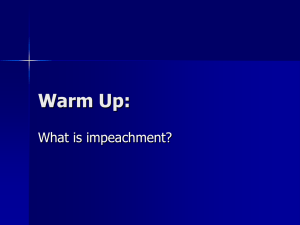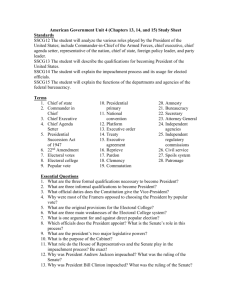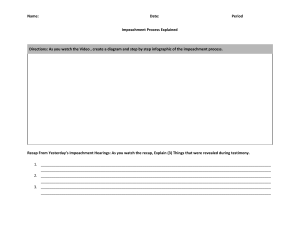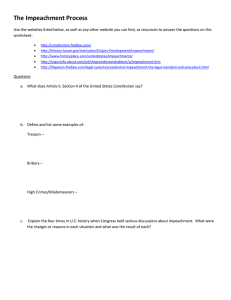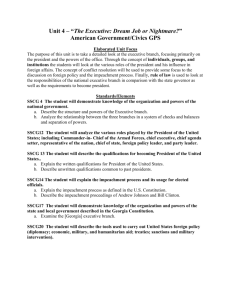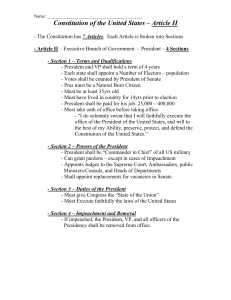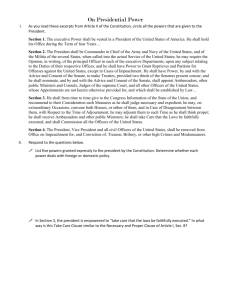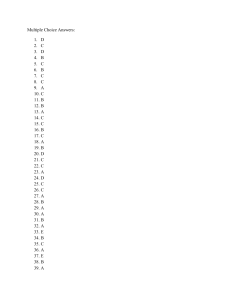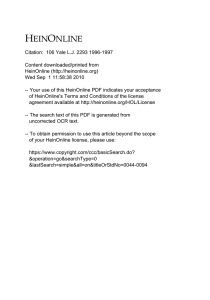The Executive Branch
advertisement
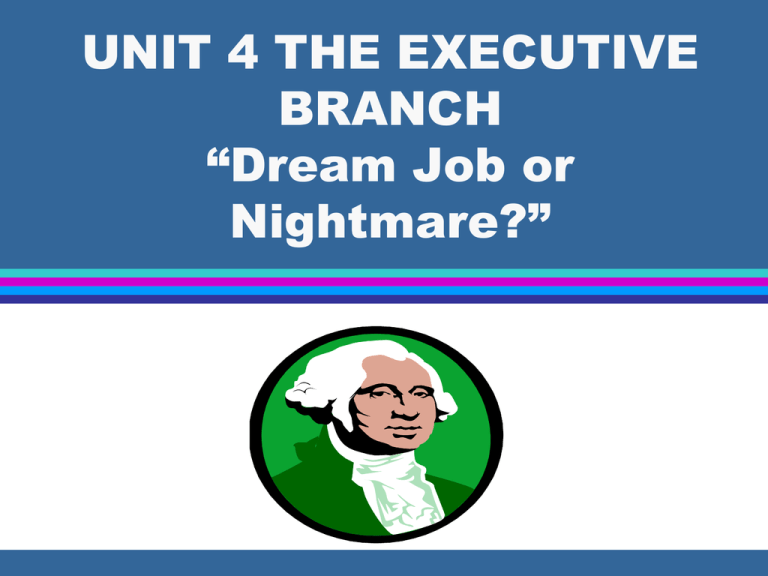
UNIT 4 THE EXECUTIVE BRANCH “Dream Job or Nightmare?” SSCG4 The student will demonstrate knowledge of the organization and powers of the national government. a. Describe the structure and powers of the legislative, executive, and judicial branches. THE EXECUTIVE BRANCH TOP 4 LEVELS OF THE EXECUTIVE BRANCH 1. The President 2. The Vice President 3. The Cabinet 4. Executive Depts. & Bureaucracy PRESIDENTIAL POWERS Commander in Chief of the Armed Forces Grant reprieves & pardons for federal offenses Call special session of Congress Receive ambassadors Execute (ENFORCE) laws Appoint officials to lesser offices Powers Shared w/ Senate Make Treaties Appoint Ambassadors, Judges, & high officials Approve Legislation (veto legislation) SSCG12 The student will analyze the various roles played by the President of the United States; include Commanderin-Chief of the Armed Forces, chief executive, chief agenda setter, representative of the nation, chief of state, foreign policy leader, and party leader. Presidential Roles Commander in Chief- Leader of All Armed Forces Chief Executive- Leader of Executive Branch Chief Agenda Setter- Sets the schedule for Executive Branch Presidential Roles Representative of the Nation- is the main person who represents our nation worldwide Chief of State- leader of our national government Foreign Policy Leader- leads how we deal with other countries Presidential Roles Party Leader- leader of his/her party. Main figure head of their political party The Oval Office White House Office “West Wing” Closest to the Pres. Presidents #1 Aid is the Chief of Staff Press Secretary- Another key part of Executive branch by means of distributing information. Secretary of Homeland Security SSCG13 The student will describe the qualifications for becoming President of the United States. a. Explain the written qualifications for President of the United States. b. Describe unwritten qualifications common to past presidents. Qualifications for Pres. & V.P. Must be 35 years old Must be a natural born citizen Must have lived in the U.S. the last 14 years Term of office: The President and V-P. are elected to four year terms The 22nd amendment limits the president to two terms or no more than 10 years Compensation Salary $400,000(2001) $50,000 for expenses $100,000 for travel White House 132 rooms and office Camp David Resort Medical & Dental Care Secret service protection-life Pension Transportation SSCG14 The student will explain the impeachment process and its usage for elected officials. a. Explain the impeachment process as defined in the U.S. Constitution. b. Describe the impeachment proceedings of Andrew Johnson and Bill Clinton Removal of President The president and vice president may be removed from office upon conviction of impeachment for high crimes and misdemeanors Impeachment Process House of Reps- votes to press charges against president which if approved will take the president to trial Senate- holds the trial to impeach the president (need 2/3 majority to impeach) 25th Amendment 1967 If President cannot complete his term, the V.P. becomes President If V.P. office is vacant, the President appoints one w/ Senate approval. Presidential Succession Act 1. Vice-President of the U.S. 2. Speaker of the House 3. President pro tem 4. Cabinet secretaries in order of department origin (State, Treasury, Defense) JOHNSON IMPEACHED Johnson’s Impeachment President Johnson enacted a lenient Reconstruction policy for the defeated South, including almost total amnesty to ex-Confederates, a program of rapid restoration of U.S.-state status for the seceded states, and the approval of new, local Southern governments, which were able to legislate "Black Codes" that preserved the system of slavery in all but its name. Johnson Impeachment 2 On February 24, Johnson was impeached, and on March 13 his impeachment trial began in the Senate under the direction of U.S. Supreme Court Chief Justice Salmon P. Chase. The trial ended on May 26 with Johnson's opponents narrowly failing to achieve the two-thirds majority necessary to convict him. CLINTON’s Impeachment After nearly 14 hours of debate, the House of Representatives approves two articles of impeachment against President Bill Clinton, charging him with lying under oath to a federal grand jury and obstructing justice. Clinton, the second president in American history to be impeached, vowed to finish his term. CLINTON IMPEACHMENT 2 The president was acquitted on both articles of impeachment. The prosecution needed a two-thirds majority to convict but failed to achieve even a bare majority. Rejecting the first charge of perjury, 45 Democrats and 10 Republicans voted "not guilty," and on the charge of obstruction of justice the Senate was split 50-50. After the trial concluded, President Clinton said he was "profoundly sorry" for the burden his behavior imposed on Congress and the American people. SSCG20 The student will describe the tools used to carry out United States foreign policy (diplomacy; economic, military, and humanitarian aid; treaties; sanctions and military intervention). Tools of Diplomacy Diplomacy- Meeting with foreign leaders to react diplomatic solutions to problems Economic Aid- sending money to help Humanitarian Aid- sending food or medical help Tools of Diplomacy Military Aid- sending military troops to train, or giving military equipment Treaties- agreeing with foreign countries to solve a problem Sanctions- putting restrictions on a country Military Intervention- Sending troops to solve a problem
